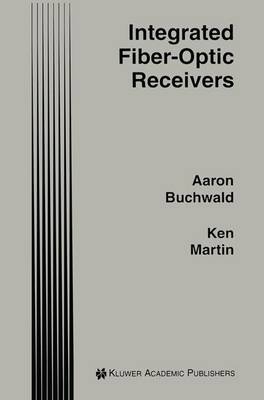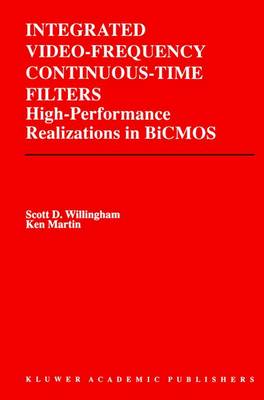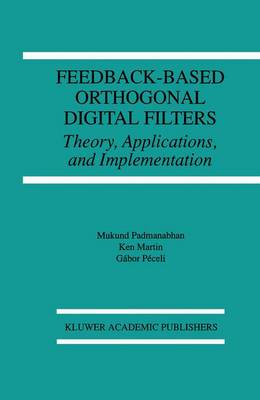The Springer International Series in Engineering and Computer Science
3 primary works
Book 306
Integrated Fiber-Optic Receivers covers many aspects of the design of integrated circuits for fiber-optic receivers and other high-speed serial data links. Fundamental concepts are explained at the system level, circuit level, and semiconductor device level. Techniques for extracting timing information from the random data stream are described in considerable detail, as are all other aspects of receiver design. Integrated Fiber-Optic Receivers is organized in two parts. Part I covers the theory of communications systems as it applies to high-speed PAM (Pulse Amplitude Modulation) systems. The primary emphasis is on clock recovery circuits.
Because theoretical concepts are generally grasped more easily by example, Part II is devoted to circuit design issues that illustrate example realizations of architectures described in Part I. Part II presents the transistor-level design, and measured results, of fundamental building blocks and test circuits.
For practicing engineers, more than just reporting on the results of specific circuits, this book serves as a tutorial on the design of integrated high-speed broadband PAM data systems, such as: repeaters in long-haul, fiber-optic, trunk-lines transceivers for use in LANs and WANs; read channels for high-density data storage devices; and wireless communication handsets. Integrated Fiber-Optic Receivers may be used as a text for advanced courses in both analog circuit design and communication systems.
Because theoretical concepts are generally grasped more easily by example, Part II is devoted to circuit design issues that illustrate example realizations of architectures described in Part I. Part II presents the transistor-level design, and measured results, of fundamental building blocks and test circuits.
For practicing engineers, more than just reporting on the results of specific circuits, this book serves as a tutorial on the design of integrated high-speed broadband PAM data systems, such as: repeaters in long-haul, fiber-optic, trunk-lines transceivers for use in LANs and WANs; read channels for high-density data storage devices; and wireless communication handsets. Integrated Fiber-Optic Receivers may be used as a text for advanced courses in both analog circuit design and communication systems.
Book 323
Integrated Video-Frequency Continuous-Time Filters
by Scott D. Willingham and Kenneth W. Martin
Published 31 July 1995
Advances in the state of the art mean the signal processing ICs of ever-increasing complexity are being introduced. While the typical portion of a large IC devoted to analog circuits has diminished, the performance of those surviving analog signal processing circuits remains vital and their design challenging. Moreover, the emerging high-definition TV technology has created a new area for IC development, one with formidable signal processing requirements. The antialiasing filters needed for one proposed HDTV decoder motivated the research documented in this book. Sharply selective filters place tight constraints on the permitted excess phase shifts of their constituent circuits. Combined with stringent requirements for low distortion at video frequencies, these constraints challenge the IC filter designer.
Integrated Video-Frequency Continuous-Time Filters: High-Performance Realizations in BiCMOS deals with what is arguably the mainstay of analog signal processing circuits. Prominent applications in computer disk-drive read channels, video receivers, rf circuits, and antialiasing and reconstruction in data converters testifies to their importance. Moreover, they are excellent benchmarks for more general analog signal processors. Bipolar and MOSFET transistors, freely combined at the lowest circuit levels, provide the designer with an opportunity to develop potent variations on the standard idioms. The book considers the general principles of BiCMOS circuit design, through to a demanding design problem. This case-study approach allows a concrete discussion of the justification for and practical trade-offs of each design decision.
Audience: A reference work for experienced IC designers and a text for advanced IC design students.
Integrated Video-Frequency Continuous-Time Filters: High-Performance Realizations in BiCMOS deals with what is arguably the mainstay of analog signal processing circuits. Prominent applications in computer disk-drive read channels, video receivers, rf circuits, and antialiasing and reconstruction in data converters testifies to their importance. Moreover, they are excellent benchmarks for more general analog signal processors. Bipolar and MOSFET transistors, freely combined at the lowest circuit levels, provide the designer with an opportunity to develop potent variations on the standard idioms. The book considers the general principles of BiCMOS circuit design, through to a demanding design problem. This case-study approach allows a concrete discussion of the justification for and practical trade-offs of each design decision.
Audience: A reference work for experienced IC designers and a text for advanced IC design students.
Book 343
Feedback-Based Orthogonal Digital Filters
by Mukund Padmanabhan, Kenneth W. Martin, and Gabor Peceli
Published 30 November 1995
Feedback-Based Orthogonal Digital Filters: Theory, Applications, and Implementation develops the theory of a feedback-based orthogonal digital filter and examines several applications where the filter topology leads to a simple and efficient solution. The development of the filter structure is linked to concepts in observer theory. Several signal processing problems can be represented as estimation problems, where a parametric representation of the input is used, to try and replicate it locally. This estimation problem can be solved using an identity observer, and the filter topology falls in this framework. Hence the filter topology represents a universal building block that can find application in several problems, such as spectral estimation, time-recursive computation of transforms, etc. Further, because of the orthogonality constraints satisfied by the structure, it also represents a robust solution under finite precision conditions.
The book also presents the observer-based viewpoint of several signal processing problems, and shows that problems that are typically treated independently in the literature are in fact linked and can be cast in a single unified framework. In addition to examining the theoretical issues, the book describes practical issues related to a hardware implementation of the building block, in both the digital and analog domain. On the digital side, issues relating to implementation using semi-custom chips (FPGA's), and ASIC design are examined. On the analog side, the design and testing of a fabricated chip, that functions as a multi-sinusoidal phase-locked-loop, are described.
Feedback-Based Orthogonal Digital Filters serves as an excellent reference. May be used as a text for advanced courses on the subject.
The book also presents the observer-based viewpoint of several signal processing problems, and shows that problems that are typically treated independently in the literature are in fact linked and can be cast in a single unified framework. In addition to examining the theoretical issues, the book describes practical issues related to a hardware implementation of the building block, in both the digital and analog domain. On the digital side, issues relating to implementation using semi-custom chips (FPGA's), and ASIC design are examined. On the analog side, the design and testing of a fabricated chip, that functions as a multi-sinusoidal phase-locked-loop, are described.
Feedback-Based Orthogonal Digital Filters serves as an excellent reference. May be used as a text for advanced courses on the subject.


